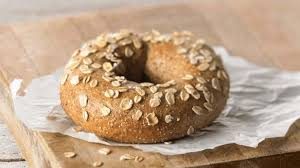you’d like. If you want a little extra sweetness, you can add a little honey, a sprinkling of sugar (not too much, though), or a packet of artificial sweetener.Boost the nutritional power of your smoothie by adding a bit of flax oil or milled flax seeds and
 some plain yogurt or peanut butter. The healthy fats and proteins combined with the fiber in the fruit will help keep you feeling full longer. Avoid commercial fruit smoothie mixes that are mostly sugar and artificial flavorings, and resist the temptation to add a couple of scoops of ice cream, which will turn your healthy breakfast smoothie into a high-calorie splurge.
some plain yogurt or peanut butter. The healthy fats and proteins combined with the fiber in the fruit will help keep you feeling full longer. Avoid commercial fruit smoothie mixes that are mostly sugar and artificial flavorings, and resist the temptation to add a couple of scoops of ice cream, which will turn your healthy breakfast smoothie into a high-calorie splurge. Leftovers: So many foods are associated with breakfast, like sweet cereals, eggs, bacon, pancakes, waffles and French toast with gobs of maple syrup. But there’s nothing wrong with eating non-breakfast foods instead, like the leftovers you have from dinner the night before. As with any healthy breakfast, be sure to include protein and plenty of fiber to help keep you full until lunch. Heat up a piece of leftover chicken with lots of green beans or other vegetables on the side. Add a slice of whole grain bread and serve with a healthy beverage like water, low-fat milk or 100-percent juice.
Leftovers: So many foods are associated with breakfast, like sweet cereals, eggs, bacon, pancakes, waffles and French toast with gobs of maple syrup. But there’s nothing wrong with eating non-breakfast foods instead, like the leftovers you have from dinner the night before. As with any healthy breakfast, be sure to include protein and plenty of fiber to help keep you full until lunch. Heat up a piece of leftover chicken with lots of green beans or other vegetables on the side. Add a slice of whole grain bread and serve with a healthy beverage like water, low-fat milk or 100-percent juice.
Have some simple foods ready for those super-busy mornings when you think you don’t have time for breakfast. Grab a couple of your favorites and breakfast is ready in less than one minute.
Individual yogurt cups
Protein bars
Individual bags of homemade trail mix
Whole-grain or bran muffins
Peeled hard-boiled eggs
Individual containers of 100-percent fruit juice
Fresh fruit like apples, bananas, and pears
Start with Breakfast
You might eat breakfast at a restaurant, a hotel continental breakfast bar, or even the food aisle of a gas station.
Avoid excess sugar and starchy foods if you’re the driver. High carbohydrate meals may improve your mood for a short time, but lots of sugar and starch can make you sleepy.
 Breakfast at a Restaurant
Breakfast at a Restaurant
Choose an omelet filled with vegetables and order a side of whole wheat toast instead of a stack of pancakes and syrup.
A bowl of oatmeal with fresh fruit is filling and good for you.
If you want something sweet, choose a bran muffin, which is a good source of fiber. Or opt for whole grain toast with just a little jam or jelly.
Hotel Continental Breakfast
Choose a whole grain cereal with low-fat milk.
Fresh fruit gives you vitamins and fiber.
Yogurt or hard-boiled eggs are good sources of protein.
Avoid sugary muffins, sweet rolls, and pre-sweetened cereal.
Service Station or Convenience Store
Look for single-serving whole grain breakfast cereals and low-fat milk.
Protein bars can make a good breakfast food substitute, but watch out for extra sugar and calories–read the labels.
As a last resort, choose a hot breakfast sandwich or small breakfast burrito over donuts and sweet rolls.
Fast Food Breakfast
Most breakfast choices have lots of calories and saturated fats, but breakfast burritos may have less than other selections.
Fruit and yogurt parfaits will give you some calcium and protein without too much saturated fat.
Drink low-fat milk or 100-percent juice instead of sodas and orange-flavored soft drinks.
Healthy Snacks for the Ride
If you’re the driver, you probably shouldn’t be snacking while you drive — it’s a distraction. The snacks that keep your passengers happy should be nutritious. Take a cooler with you to keep snacks and beverages cold.
When you stop for gas and restroom breaks, look for a local grocery store. You’ll find healthier foods, and they’ll probably be less expensive than what you’ll find at a gas station.
 Load up the cooler with fresh-cut vegetables and fruit.
Load up the cooler with fresh-cut vegetables and fruit.
Bring plenty of water. It will keep you hydrated and if you spill it won’t stain the upholstery. Individually wrapped portions of string cheese or vegetarian cheese alternatives can be stored in the cooler as a source of calcium and protein. Bring baked whole grain crackers along on your trip, for added fiber and nutrients. Don’t overindulge in greasy chips, choose baked varieties that have fewer unhealthy fats. Pack sandwiches made with whole grain bread and peanut butter or lean meats. Almonds, cashews, and walnuts contain polyunsaturated fats and are easy to take on a trip in either individual bags or larger containers.
Lunch and Dinner
Eating lunch and dinner on the road usually means going to a restaurant. Don’t spend too much time at fast food restaurants; instead, opt for full-service restaurants that offer more choices.
Healthy Restaurant Options
Order soup or salad to eat as your main course. Skip the entree altogether unless you’re really hungry.
Split a meal with your dining partner. Most restaurants serve huge portions, so there is usually enough food to share. You’ll save calories and money. Besides, sharing eliminates the temptation to take leftovers back on the road, where they can’t be properly stored.
Select foods that are prepared with healthier methods. Baked chicken is healthy, but fried chicken has too much fat and calories. Eat the vegetables. Most entrees come with at least one vegetable. If not, be sure to order a vegetable side dish.
Skip dessert, or choose some fruit.
Fast Food Dinners
Find sandwich shops like Subway or Quiznos. Choose whole grain bread, lean meats, and lots of vegetables.
Many fast food restaurants offer salads, but you need to be careful. Some of those salads are very high in fat, especially taco salads or those topped with fried chicken strips.
Don’t super-size your meal. It sounds like a great deal, but you’ll consume too many calories and too much fat and sodium.
Order sandwiches made with grilled chicken rather than fried chicken.
At the Hotel
If your trip requires a hotel stay, you might get a bit hungry after a long day of travel. If going to a restaurant is not an option, you should still be able to find healthy foods. Locate a local grocery store and buy fruit, nuts, or healthy choices from the salad bar or deli section. If your hotel has a microwave, you can find healthier frozen dinners or soup. If your only choice for a snack is the hotel vending machine, skip the candy and chips and look for nuts or microwave popcorn. Some restaurants will deliver food to your hotel room and may have some healthy menu items available. If you go for a pizza delivery, don’t order extra cheese or meats high in saturated fat. Choose lots of vegetable and mushrooms (and order a side salad too).


Comments are closed